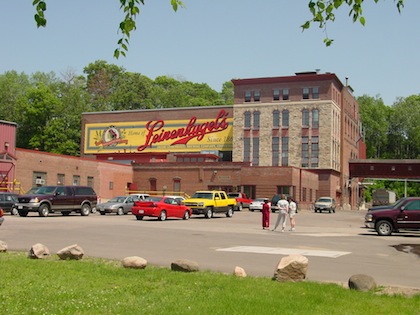Starting about 1950, these mainly Midwest shipping breweries began to open new facilities across the country, in California, Texas, New York and the South. That slashed their shipping costs and “suddenly, they have a lot of money to play around with,” said Scherer. “So they advertised like hell to reinforce their premium image.”
And where did they advertise? Television, of course. It was the dawning of nationally televised sporting events–NBC’s baseball “Game of the Week,” “Gillette Cavalcade of sports Friday night fights”–and for the first time large breweries could reach the entire country with a single ad.
A common misperception of the era holds that the big guys simply swallowed up the little fish. In fact, the Justice Department fought most brewery mergers, so the national breweries instead grew from within–a tack that actually sealed the fate of the regionals. With advanced equipment, the big companies could brew beer more cheaply, faster and more efficiently, further increasing profits.
The weaker competition tried to keep up, with more advertising, new products and new blood. But it was too little, too late.
Ballantine, brewing since Martin Van Buren was president, left Newark in 1972. Joseph Schlitz, which had been America’s biggest brewery as recently as 1950, would collapse in 1982. When Christian Schmidt & Son shut down in 1987, it left Philadelphia without a brewery for the first time since the city was founded three centuries earlier.
Falstaff, farewell.
Goebel, gone.
Schaefer, see ya later.
The depth of the transformation was stunning. Consider that Prohibition itself cost the nation about half of its breweries. The 50 years after Prohibition would see the collapse of 85 percent of those survivors.
By 1980, four of every five American beers were manufactured by just six companies.
“There was an enormous shakeout,” said Scherer, now a professor emeritus in the John F. Kennedy School of Government at Harvard University. “It was an all-out shootout.”
Jake Leinenkugel had a front-row seat for bloodshed. Born in 1952, he grew up watching his father hold off the wolves. “Pabst, Budweiser, Miller, even Olympia, Hamm’s, Schmidt, Grain Belt—they all came into our territory,” Leinenkugel said. “Twelve new beers in something like five years. That’s a heck of a wakeup call.”
Like any decent brewer, Leinenkugel credited his company’s quality beer for the company’s survival. But he acknowledged it took more than that. The company built a tour center, sold T-shirts and baseball caps and developed a deep connection with its customers. Then, Leinenkugel said, “we got lucky.” In 1978 Newsweek magazine praised Leinie’s as the best local beer in America, describing it as “a nippy brew perfect for those times when you take a few more pops than is your custom.”
Sales spiked nearly 20 percent.










